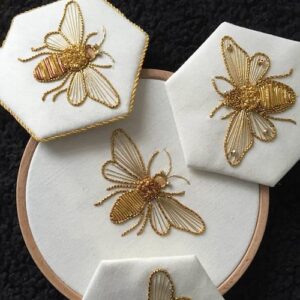Everything you need to know about
Khurja Pottery.
What is pottery?
Pottery is a method and the items of preparing vessels and various other items manufactured with the use of clay and other ceramic items.
These are burnt at high temperatures for a robust and long-lasting form.
Main types of pottery comprise earthenware, stoneware and porcelain.
Pottery is also known as a place where the potters prepare wares.
Anciently in archaeology, “pottery” usually meant only the vases, figures and so on.
The similar substance is known as Terracotta.
The potters often require clay, which is used in the pottery work.
What is Khurja Pottery?
Khurja pottery is conventional Indian pottery work.
It is practised in the city of Khurja, located in Uttar Pradesh.
Khurja pottery has been secured under the GI or Geographical Indication.
It is ranked 178 in the list of India’s GI Act 1999.
The Controller General approves Patents Designs and Trademarks.
What do we know about Khurja?
Khurja is a city located in Uttar Pradesh, India.
The city provides ceramics to a large extent in India with 500 factories engaged in ceramics work.
Khurja is known as The Ceramics City due to the large extent of ceramics supplied.
Moreover, the city provides delicious sweets.
These sweets are known as Khurchan.
Delhi and Khurja are far from each other at a distance of 85 kilometres.
Pashtuns, prominent settlers of Khurja.
They belong to the Kheshgi Dynasty of Timur’s army.
Khurja is an Urdu word meaning condemned.
The profit was ignored as the land comprised multiple swamps, and agricultural opportunities were shallow.
The raw material
Clay
It is an essential raw material.
Different types of clay powder, namely Quarts clay, Phosphate clay, Bikaner clay and china clay, are combined with clay dough.
Plaster of Paris
Plaster of Paris or POP is used to make moulds for moulding ceramic article.
These consume water, and the item takes shape.
Oxide chemical colours
These colours are used to add colour to the items processed from iron, cobalt, chromium oxide, etc.
These colours are combined with the glaze solution and used on the items; the reaction can be seen upon heating and gives the desired colour.
Glaze solution
The solution gives shine to the item. Furthermore, it gives a nice colour and composition on the finished items.
Kiln
It helps in heating the items after manufacturing them.
Jigger and Jolly machine
The machine makes the small item by the use of the mould.
The making process
Preparing the clay
All raw materials are combined in a ratio and ground in a Ball-mill machine for almost 15 hours.
The ration is their trade secret. It is done to obtain a uniform mix of the clay mixture, and it is then put between the pan filter to keep only the required amount of water content and clay disc of 0.75 feet radius.
It is the product of this process.
Clay discs are passed repeatedly through the Pug-mill machine for the pugging method to obtain the superfine clay mixture— the Archimedes screw in the pug-mill forces the clay in a straight and upward movement.
Liquid clay and solid clay are two clay material obtained.
Clay moulding process
The moulding method is practised for large products.
These include vessels, containers, and pots.
The mould for the item is settled using POP or Plaster of Paris.
Clay is combined in a blended solution without any presence of lumps.
Clay result is discharged into the mould until the cavity is added in the mould.
The mould box is rotated smoothly to eliminate bubbles and keep the only required amount of clay.
Smoothening and painting process
Shrivelled goods are constrained to a semi-finish method to enhance the outer surface by sanding performed with sandpaper.
Pictures in ceramic pottery are classified into Mughal art (old art) and conventional art with themes on the exterior finish.
Mughal art is the traditional craft painted with cobalt or Cb-bluish colour accompanied by a (Pb glazing) colourless lead.
As compared to the conventional art, it involves adding themes such as floral or geometric designs on the Khurja pottery.
Glazing process
Glazing is a glossy coating combined with ceramic items.
It used to paint, embellish, waterproof, and strengthen the ceramic.
Glazes can be of any finish, for example, transparent, translucent, and many more.
Glazes are produced using three essential components like glass former, melter, and binder.
Firing process
It is a step performed in a covered kiln.
Earlier, a brick kiln was used, but now an electric kiln with a feature of a temperature control facility is used as this is more convenient for the worker and eliminates various losses.
What are the advantages of clay for health?
- Cooking done using a clay pot gives ample moisture and benefits of using less oil and gas.
- Clay has alkaline properties.
- Therefore, when food is cooked, the PH level is balanced, and the food is less acidic.
- The slow food preparation method preserves all the health benefits of the food prepared in clay pots.
- If the pot is seasoned appropriately, food will be appropriate to consume for more time.
- Khurja pots are found to be in good condition for 3 to 4 years.
What are the items produced by the workers?
About 15,000 people work as official workers, while about 25,000 work as unofficial workers.
These workers handle work in 500 different units and approximately 400 factories.
They manufacture various types of items like some of which include:
- Crockery wares
- Art wares
- Electrical products
- Sanitary wares
- Tiles
- Household products
What is the present status of Khurja Pottery?
Modern-day pottery saw a rise in the 1940s.
The Uttar Pradesh government established a factory in 1942 for pottery work.
However, the factory was shut down between 1946– 1947 as there were problems associated with the quality.
In 1952, the factory converted into a Pottery Development Centre.
From 1942 to the present, some enactments, changes, and initiatives taken by different actors to improve pottery production.
It led to an inherent role of Khurja pottery in the nation, and items were shipped to international countries.
Where is the Khurja Pottery sold?
Khurja pottery is sold in India and international markets.
Almost 23 export-oriented units are established for Khurja pottery work.
If reports are believed, 2,500 million Indian Rupees were collected for the pottery work by trading the items from 1999 to 2000.
These include exports amounting to 148.2 million Indian Rupees.
Which is the oldest centre for Khurja Pottery?
According to the writer of “Pottery-making Cultures and Indian Civilization,” Khurja is among the oldest cities for India’s pottery.
Also, according to him the potters responsible for Khurja pottery claim themselves to be Multani Kumhars as they belong to Multan.
How is the demand for Khurja pottery?
Khurja’s pottery made it in the Olympic Games in the Brazilian city of Rio de Janeiro in 2016.
Demand for Khurja coffee mugs, milk mugs and bowls in the Olympics increased. One of the reasons for the increasing demand for Khurja’s pottery is that the Brazilian government has imposed a 200-fold anti-dumping tax on Chinese ceramics.
Both Indian and foreign players and viewers who witnessed the Olympic Games were welcomed with Khurja pottery.
Pottery entrepreneur Darshan Chhatwal said that Olympic players used Indian mugs and bowls for coffee and milk.
Did we miss something?
Let us know in the comments down below!













